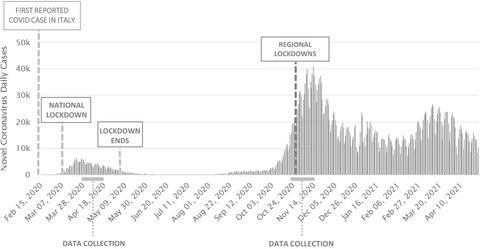当前位置:
X-MOL 学术
›
J. Neuroendocrinol.
›
论文详情
Our official English website, www.x-mol.net, welcomes your
feedback! (Note: you will need to create a separate account there.)
The psychological impact of COVID-19 pandemic on patients with neuroendocrine tumors: Between resilience and vulnerability
Journal of Neuroendocrinology ( IF 3.3 ) Pub Date : 2021-09-20 , DOI: 10.1111/jne.13041 Eleonora Lauricella 1 , Mauro Cives 1, 2 , Alessandra Bracigliano 3 , Ottavia Clemente 3 , Valentina Felici 1 , Rossella Lippolis 1 , Brunella Amoruso 1 , Eleonora Pelle' 1 , Barbara Mandriani 1 , Chiara Esposto 1 , Cira Forte 3 , Francesco Perri 3 , Camillo Porta 1 , Salvatore Tafuto 3
Journal of Neuroendocrinology ( IF 3.3 ) Pub Date : 2021-09-20 , DOI: 10.1111/jne.13041 Eleonora Lauricella 1 , Mauro Cives 1, 2 , Alessandra Bracigliano 3 , Ottavia Clemente 3 , Valentina Felici 1 , Rossella Lippolis 1 , Brunella Amoruso 1 , Eleonora Pelle' 1 , Barbara Mandriani 1 , Chiara Esposto 1 , Cira Forte 3 , Francesco Perri 3 , Camillo Porta 1 , Salvatore Tafuto 3
Affiliation

|
The COVID-19 pandemic has added another layer of complexity to the fears of patients with neuroendocrine tumors (NETs). Little is known regarding the psychological impact of the COVID-19 outbreak on patients with gastroenteropancreatic or bronchopulmonary (BP) NETs. We longitudinally surveyed the mental symptoms and concerns of NET patients during the plateau phase of the first (W1) and second epidemic waves (W2) in Italy. Seven specific constructs (depression, anxiety, stress, health-related quality of life, NET-related quality of life, patient–physician relationship, psychological distress) were investigated using validated screening instruments, including DASS-21, EORTC QLQ-C30, EORTC QLQ GI.NET21, PDRQ9 and IES-R. We enrolled 197 patients (98 males) with a median age of 62 years. The majority of the patients had G1/G2 neoplasms. Some 38% of the patients were on active treatment. At W1, the prevalence of depression, anxiety and stress was 32%, 36% and 26% respectively. The frequency of depression and anxiety increased to 38% and 41% at W2, whereas no modifications were recorded in the frequency of stress. Poor educational status was associated with higher levels of anxiety at both W1 (odds ratio [OR] = 1.33 ± 0.22; p = .07) and W2 (OR = 1.45 ± 0.26; p = .03). Notably, post-traumatic stress symptoms were observed in the 58% of the patients, and both single marital status (OR = 0.16, 95% confidence interval [CI] = 0.06–0.48; p = .0009) and low levels of formal education (OR = 0.47, 95% CI = 0.23–0.99; p = .05) predicted their occurrence. No significant deteriorations of health-related quality of life domains were observed from W1 to W2. High patient care satisfaction was documented despite the changes in health systems resource allocation. NET patients have an increased risk of developing post-traumatic stress symptoms as result of the COVID-19 pandemic. Specific screening measures and psychological interventions should be implemented in NET clinics to prevent, recognize and treat mental distress in this vulnerable population.
中文翻译:

COVID-19大流行对神经内分泌肿瘤患者的心理影响:韧性与脆弱性之间
COVID-19 大流行让神经内分泌肿瘤 (NET) 患者的恐惧变得更加复杂。关于 COVID-19 爆发对胃肠胰或支气管肺 (BP) NET 患者的心理影响知之甚少。我们纵向调查了意大利第一波(W1)和第二波疫情(W2)平台期NET患者的精神症状和担忧。使用经过验证的筛查工具(包括 DASS-21、EORTC QLQ-C30、EORTC)对七种特定结构(抑郁、焦虑、压力、健康相关生活质量、NET 相关生活质量、医患关系、心理困扰)进行了调查QLQ GI.NET21、PDRQ9 和 IES-R。我们招募了 197 名患者(98 名男性),中位年龄为 62 岁。大多数患者患有G1/G2肿瘤。约38%的患者正在接受积极治疗。第一周时,抑郁、焦虑和压力的患病率分别为 32%、36% 和 26%。在第 2 周,抑郁和焦虑的频率分别增加到 38% 和 41%,而压力频率没有变化。教育状况不佳与 W1(比值比 [OR] = 1.33 ± 0.22; p = .07)和 W2(OR = 1.45 ± 0.26; p = .03)的较高焦虑水平相关。值得注意的是,58% 的患者观察到创伤后应激症状,且均为单身婚姻状况(OR = 0.16,95% 置信区间 [CI] = 0.06–0.48; p = .0009)且正规教育水平较低(OR = 0.47,95% CI = 0.23–0.99; p = .05)预测了它们的发生。从第 1 周到第 2 周,没有观察到健康相关生活质量领域的显着恶化。 尽管卫生系统资源分配发生了变化,但患者护理满意度仍然很高。由于 COVID-19 大流行,NET 患者出现创伤后应激症状的风险增加。 NET诊所应实施具体的筛查措施和心理干预措施,以预防、识别和治疗这一弱势群体的精神困扰。
更新日期:2021-10-15
中文翻译:

COVID-19大流行对神经内分泌肿瘤患者的心理影响:韧性与脆弱性之间
COVID-19 大流行让神经内分泌肿瘤 (NET) 患者的恐惧变得更加复杂。关于 COVID-19 爆发对胃肠胰或支气管肺 (BP) NET 患者的心理影响知之甚少。我们纵向调查了意大利第一波(W1)和第二波疫情(W2)平台期NET患者的精神症状和担忧。使用经过验证的筛查工具(包括 DASS-21、EORTC QLQ-C30、EORTC)对七种特定结构(抑郁、焦虑、压力、健康相关生活质量、NET 相关生活质量、医患关系、心理困扰)进行了调查QLQ GI.NET21、PDRQ9 和 IES-R。我们招募了 197 名患者(98 名男性),中位年龄为 62 岁。大多数患者患有G1/G2肿瘤。约38%的患者正在接受积极治疗。第一周时,抑郁、焦虑和压力的患病率分别为 32%、36% 和 26%。在第 2 周,抑郁和焦虑的频率分别增加到 38% 和 41%,而压力频率没有变化。教育状况不佳与 W1(比值比 [OR] = 1.33 ± 0.22; p = .07)和 W2(OR = 1.45 ± 0.26; p = .03)的较高焦虑水平相关。值得注意的是,58% 的患者观察到创伤后应激症状,且均为单身婚姻状况(OR = 0.16,95% 置信区间 [CI] = 0.06–0.48; p = .0009)且正规教育水平较低(OR = 0.47,95% CI = 0.23–0.99; p = .05)预测了它们的发生。从第 1 周到第 2 周,没有观察到健康相关生活质量领域的显着恶化。 尽管卫生系统资源分配发生了变化,但患者护理满意度仍然很高。由于 COVID-19 大流行,NET 患者出现创伤后应激症状的风险增加。 NET诊所应实施具体的筛查措施和心理干预措施,以预防、识别和治疗这一弱势群体的精神困扰。











































 京公网安备 11010802027423号
京公网安备 11010802027423号